View in other NatureServe Network Field Guides
NatureServe
Montana
Utah
Wyoming
Idaho
Wisconsin
British Columbia
South Carolina
Yukon
California
New York
Red-root Flatsedge - Cyperus erythrorhizos
State Rank Reason (see State Rank above)
Known in Montana from one Prairie County collection in 2008. Previous reports were based upon mis-identified specimens. Survey work in appropriate habitat would likely discover additional locations in Montana. Additional site and population information is needed to more precisely rank the species.
- Details on Status Ranking and Review
Population Size
Score2-3 - Very Small to Small: Population size is imprecisely known but is believed to be <10,000 individuals.
CommentUndocumented though would appear to be small.
Range Extent
Score2-3 - Local or Regional Endemic: Species has a small to very small range, though its distribution is either imprecisely documented or information to precisely categorize it was lacking at the time its status was reviewed.
Area of Occupancy
Score3 - Very Low: Generally occurring in 3 or fewer Subwatersheds (6th Code HUC’s).
Environmental Specificity
Score1 - Moderate: Species is restricted to a specific habitat that is more widely distributed or to several restricted habitats and is typically dependent upon relatively unaltered, good-quality habitat (C Values of 5-7).
Trends
ScoreNA - Rank factor not assessed.
CommentUnknown.
Threats
ScoreNA - Rank factor not assessed.
CommentUnknown.
Intrinsic Vulnerability
Score0-1 - Low to Moderate Vulnerability.
Raw Conservation Status Score
Score
8 to 11 total points scored out of a possible 13 (Rarity factors only).
General Description
Caespitose annual. Stems ascending to erect, 10–70 cm. Leaves mainly basal, 2–9 mm wide, V- or W-shaped in cross-section. Inflorescence of hemispheric clusters of ovoid spikes of sessile spikelets. Spikelets cylindric, 3–10 mm long. Scales gold, apiculate, 1.5–2 mm long with 3 obscure, median veins. Flowers: stamens 3; style 3-branched. Achene elliptic, brown, 3-sided, 0.5–1 mm long, apiculate (
Lesica et al. 2012. Manual of Montana Vascular Plants. BRIT Press. Fort Worth, TX).
Phenology
Fruit mature in August.
Diagnostic Characteristics
Similar species include C. rivularis, C. acuminatus and C. aristatus, but all have globose rather than elongate spikes.
Species Range
Montana Range
Range Descriptions
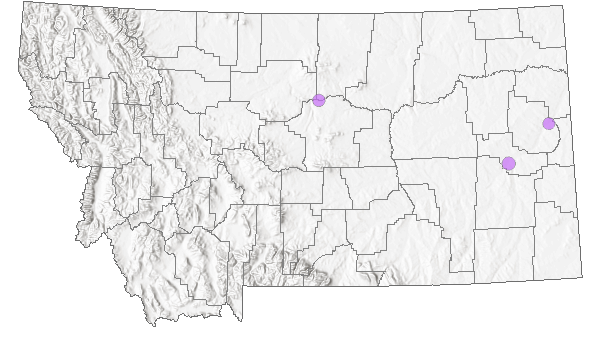
 Native
Native
Range Comments
Throughout most of temperate U.S., Mexico. Known from Prairie County (Lesica et al. 2012. Manual of Montana Vascular Plants. BRIT Press. Fort Worth, TX).
Observations in Montana Natural Heritage Program Database
Number of Observations: 3
(Click on the following maps and charts to see full sized version)
Map Help and Descriptions
Relative Density
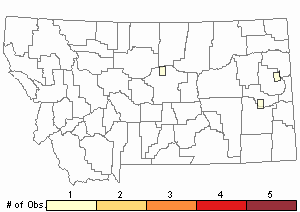
Recency
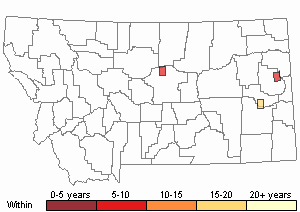
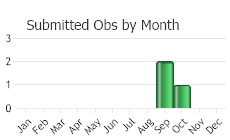
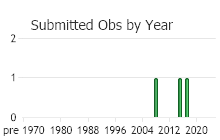
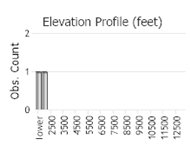 (Observations spanning multiple months or years are excluded from time charts)
(Observations spanning multiple months or years are excluded from time charts)
Habitat
Reported elsewhere from valleys and lowlands, especially along the shores of major rivers.
Ecological Systems Associated with this Species
Stewardship Responsibility
Threats or Limiting Factors
STATE THREAT SCORE REASON
Threat impact not assigned because threats are not known (MTNHP Threat Assessment 2021).
References
- Literature Cited AboveLegend:
 View Online Publication
View Online Publication Lesica, P., M.T. Lavin, and P.F. Stickney. 2012. Manual of Montana Vascular Plants. Fort Worth, TX: BRIT Press. viii + 771 p.
Lesica, P., M.T. Lavin, and P.F. Stickney. 2012. Manual of Montana Vascular Plants. Fort Worth, TX: BRIT Press. viii + 771 p. MTNHP Threat Assessment. 2021. State Threat Score Assignment and Assessment of Reported Threats from 2006 to 2021 for State-listed Vascular Plants. Botany Program, Montana Natural Heritage Program, Helena, Montana.
MTNHP Threat Assessment. 2021. State Threat Score Assignment and Assessment of Reported Threats from 2006 to 2021 for State-listed Vascular Plants. Botany Program, Montana Natural Heritage Program, Helena, Montana.
- Additional ReferencesLegend:
 View Online Publication
View Online Publication
Do you know of a citation we're missing? Lesica, P., M.T. Lavin, and P.F. Stickney. 2022. Manual of Montana Vascular Plants, Second Edition. Fort Worth, TX: BRIT Press. viii + 779 p.
Lesica, P., M.T. Lavin, and P.F. Stickney. 2022. Manual of Montana Vascular Plants, Second Edition. Fort Worth, TX: BRIT Press. viii + 779 p.
- Web Search Engines for Articles on "Red-root Flatsedge"





